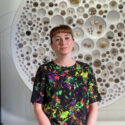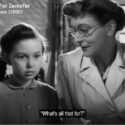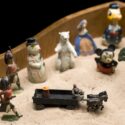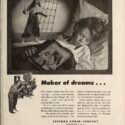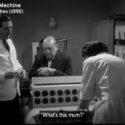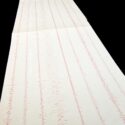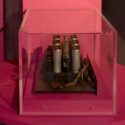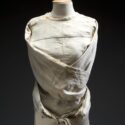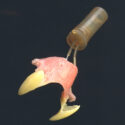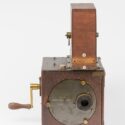Objects of the Mind: using film to explore the entangled histories of media and mental health
Article DOI: https://dx.doi.org/10.15180/242103
Abstract
This article presents the findings of an Arts and Humanities Research Council (AHRC) project, Objects of the Mind: engaging publics in the material cultures of media and mental health (AH/W002140/1), which was co-investigated by academics at the University of East Anglia and the University of Manchester and curators from across the Science Museum Group (SMG). Through this co-investigation we sought to tap into public interest in the SMG object collections and the accessibility of popular films (supplied by partners StudioCanal) to engage new audiences for our research on the interactions of psychiatry and cinema. From the museum perspective, we sought to use this research to ask new questions and tell new stories about the SMG objects, and to foster cross-collection dialogue between medicine (Science Museum) and media (National Science and Media Museum) collections. We discuss a range of events, activities and outputs we delivered towards these aims, but focus particularly on three new films we produced that (re)combined museum objects, feature film clips and expert interviews to tell new, enhanced or entangled stories about and across the collections. We will use these three short films to demonstrate three dialogues the project fostered: between museum collections; between histories; and between academic disciplines.
Keywords
child psychology, cinema, electroencephalography, film, film studies, History of Medicine, Margaret Lowenfeld, media studies, medical humanities, psychiatry, straitjacket
Introduction
https://dx.doi.org/10.15180/In 2017–18, our AHRC-funded project Demons of the Mind (DoM) offered the first interdisciplinary study of the interactions of the ‘psy’ sciences and cinema in the defining ‘long 1960s’ period (Marwick, 2005), when psychiatrists, psychologists and psychoanalysts intervened in and influenced film culture in unprecedented ways. The project can be understood in the context of an expanding literature on the co-constitutive relationship between psychiatry and film, which looks at the varied ways in which cinema has provided new metaphors for imagining the activities of the human mind (Holmes, 2017; Harbord, 2019; Joice, 2022; Evans and Harbord, 2024). A key but unexpected finding of our Demons of the Mind research was the vital role played by objects – psychiatric instruments, laboratory equipment, diagnostic tools, psychological tests, perceptual experiments – as the embodied materiality of the psychological ideas that the films circulated and contested (Snelson, Macauley and Kirby, 2024). These objects were employed not only to enhance the realism of these films, but also marshalled for rhetorical purposes. For example, across the long 1960s period a number of Hollywood deinstitutionalisation films and British anti-psychiatry films used scenes detailing the (mis)use of electroconvulsive therapy technologies as pivotal narrative devices in order to raise questions about the efficacy and ethics of their use. Some of these films were deemed as sensational and banned from public screening in the UK (Snelson and Macauley, 2021), whilst others were seen as shocking by audiences because they authentically depicted the mundane and routine use of these technologies within the NHS (Snelson, 2021).
In 2022–23, the follow-on project Objects of the Mind (OoM) allowed us to extend the narrative we were crafting, not by asking new research questions, but by revisiting the original ones in relation to the objects employed within the cinematic production of these films. By looking at the converging material cultures of media and medicine, we were able to reframe our research for new audiences, whilst demonstrating the public value of looking at objects. OoM had three key aims: 1) to tap into public interest in the SMG’s object collections and awareness of popular films as tools to engage larger and more diverse audiences for the DoM findings; 2) to utilise the DoM research to tell new stories about and across the Science Museum (SCM) and National Science and Media Museum’s (NSMM) science, medicine and media collections; 3) to create fruitful dialogue and creative collaboration between the media and medical history academics and curators across the SMG.
Employing principles of recontextualisation and recombination, we used research on and clips from popular fiction films to tell new stories about and across the Science Museum’s psychology, psychiatry and anthropometry collections and National Science and Media Museum’s cinematography and television collections. We sought to demonstrate the value of recombining popular media and museum objects outside of established taxonomies, to reveal entangled stories across collections, through the production of: a new ‘Cinema and Psychology’ Objects and Stories series; three new films for gallery display that featured clips from fiction films alongside images and discussions of the objects they featured; and interactive screenings and tours of the NSMM stores. Ultimately, we hoped the OoM project would feed into institutional level research priorities in fostering better understandings of the SMG collections and thinking about new stories that the SCM and NSMM could tell about them.
Objects and films: using cinema to make connections across collections
Looking at the objects in the museum collections required a focus on different time periods that extended and enhanced the reach of the original DoM research. For example, the Theremin, an electronic musical instrument invented in the 1920s, has been used in sound scores of ‘psychological films’ to evoke psychotic episodes or perceptual shifts from the early sound-era until today. Working with the SMG, therefore, necessitated a temporal reframing of our research questions and findings within the longue durée of the objects and technologies that made them possible. Working with curators provoked us to rethink the underpinnings of our research and, further, allowed us to provoke reflection on their curatorial practices. The OoM project was conceived as building upon rather than challenging the collections-focused curatorial practices within the SMG, feeding into their principal concerns of telling new and more complex stories about and across the collections, and enhancing opportunities for greater personal and participatory connections to the objects and their uses (Boon et al, 2017; Bond et al, 2020). The OoM project was conceptualised in the context of the Tangible Things research conducted by Harvard historians and curators. That project demonstrated the potential of recombination of objects to create unlikely juxtapositions (‘things unplaced’) or inclusions (‘things out of place’), and to use these to ask different questions of the objects (‘things in stories–stories in things’). As the authors explained, ‘These objects and their entangled stories offer proof that the study of particular things can lead to far-reaching historical discoveries by revealing patterns, relationships, and complexities that would otherwise remain hidden’ (Thatcher Ulrich et al, 2015, p 15).
As an alternate grouping of media scholars, historians and curators we were looking to make similarly enlivening connection across object collections – in this case the psychology, psychiatry and anthropometry (SCM) and the cinematography and television collections (NSMM) – that would allow us to explore, understand and communicate the converging histories of mental health and media we uncovered, as well as their reverberations in the present. However, for OoM we added another element of recombination in adding in popular films as a way to reveal and provoke further juxtapositions, inclusions and, we hoped resultantly, new stories. In order to foster and communicate the dialogues the project sought – between museum collections; between histories; and between academic disciplines – we created three new short films to be exhibited on-gallery alongside the museum objects that they depicted. The clips were selected from feature films supplied by our project partners StudioCanal that we identified as connecting explicitly to the psychiatry and psychology collections on display in the Wellcome Medical Galleries. The British feature films selected as the main case studies for our new short films were the family melodrama No Place for Jennifer (1950), the crime-science fiction film The Brain Machine (1955) and comedy drama Morgan! A Suitable Case for Treatment (1966). The selected films prominently featured, respectively, the toys and sand trays used in Margaret Lowenfeld’s World Technique, the electroencephalograph (EEG) and the straitjacket. As the following sections and their corresponding short films will demonstrate, the objects were more than merely props within these old feature films, being employed as central plot devices and/or key visual metaphors that demonstrated the films’ wider themes.
Lowenfeld’s sand trays: capturing children’s inner worlds in therapy and on film
Responding to an identified desire within the SMG, our research offered opportunities to dissolve boundaries between previously distinct museum collections. Using commercially produced fiction films as a bridge, we sought to reunite medical and media objects with their entangled histories. This aligned our and the SMG’s shared interests in telling non-linear stories about material objects and the ideas they embody. We identified the topic of exploring children’s inner worlds as a useful one to explore how filmmakers and psy professionals – and the different technologies and techniques they employed – aligned in seeking to understand child psychology. In the first film we produced, we identified how from the birth of cinema the innovations of inventor-filmmakers like the Lumière brothers allowed them to capture children’s emotional responses and experiences in a way that had not been possible before. In Repas de bébé (1895), one of earliest films to be publicly screened, Louis Lumière used his newly developed 35mm Lumière Cinematographe camera and projector to document the surprised reactions on an infant’s face.
The main focus for the above OoM film was the post-war British melodrama No Place for Jennifer (1950). As curator Selina Hurley points out in our film, Margaret Lowenfeld is an interesting and unusual choice for this film. Whilst Lowenfeld has had a major and ongoing impact on child therapy, she has had little historical attention, particularly compared to her contemporaries Anna Freud and Melanie Klein (Hubbard, 2016). This was key to the Science Museum’s bold decision to foreground her work and legacy in their ‘In the Therapist’s Room’ section of the Medicine and Treatments gallery, rather than more familiar names. Whilst there were similarities between the psychodynamic underpinnings of Lowenfeld and Klein and Freud’s approaches, there were also significant differences. All were interested in how transference (the redirection of emotions and feelings onto another) was enacted within the therapeutic relationship, but Lowenfeld was interested in the transference between child and object specifically rather than between child and therapist (for Klein and Freud objects used in play therapy were merely tools to enhance communication and connection with the therapists). This has interesting parallels with the use of the objects in the films we researched, like No Place for Jennifer, where the objects could be seen as independent agents of change within the narratives.
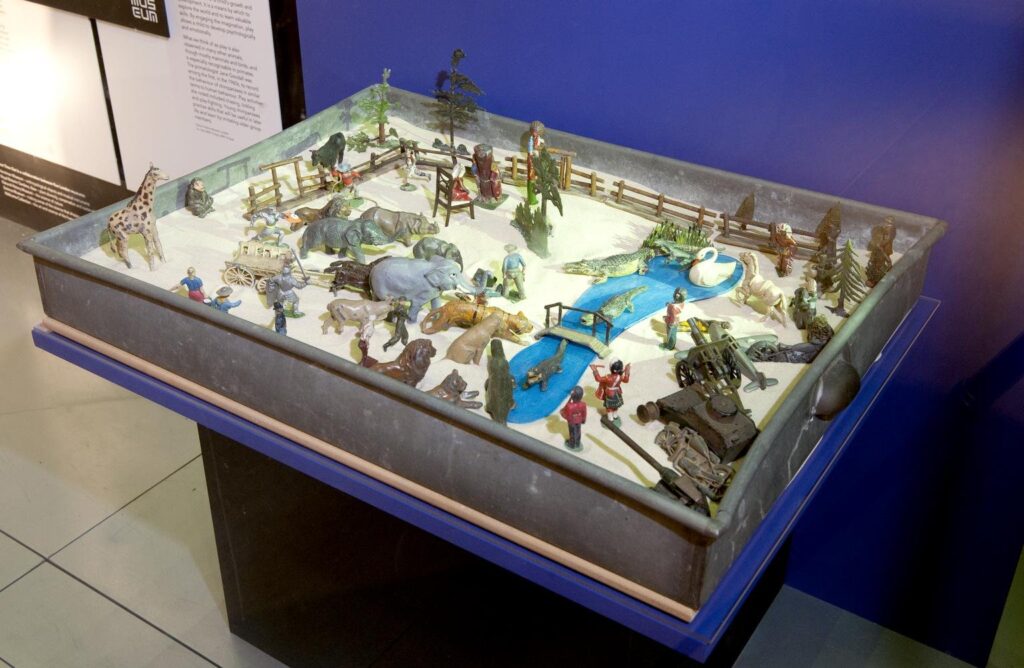
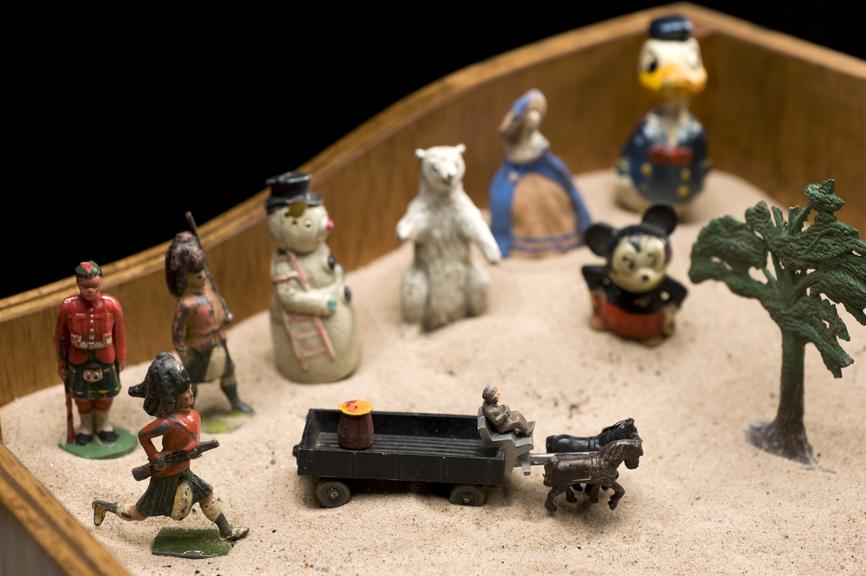
Unlike most other techniques and tests within psychiatry and psychology at the time, Lowenfeld’s World Technique was born out of popular culture. Lowenfeld’s inspiration was sci-fi novelist H G Wells’s popular non-fiction book Floor Games (1911), and her personal copy of the book is in the Science Museum’s collection. Furthermore, the toys employed in the technique were not specially made for this purpose but were mass produced toys and models made by brands such as Britains and Meccano, which were widely available from the early twentieth century onwards (Hayward, 2022). The tools required for this technique were freely available rather than proprietary and elitist in the way that, for example, the intensely guarded production and circulation of Rorschach inkblots were. Furthermore, Lowenfeld understood children’s engagement with the World Technique as influenced by their cinematic imaginations in how they drew upon visual language and storytelling techniques from their watching of feature films and film serials. In a speech to the British Psychological Society in 1937 – where Carl Jung observed her technique for the first time – Lowenfeld identified the cinematic nature of the worlds children created, explaining ‘they may be vivid and moving suggesting a cinema film more than anything else for the rapidity of movement. The Worlds of many weeks may show a continuous story, each successive afternoon’s work being the development and continuation of the previous one’ (1988, p 252). Whilst, as far as we know, Lowenfeld did not film her work with children, many of her contemporaries (including her friend Margaret Mead) did use more available and affordable 16mm film technologies in their treatment and research with mothers and children around this time (Joice, 2022).
Whilst psychologists and social scientists looked to film to help understand and enhance their research, filmmakers increasingly looked to the psy sciences in seeking to understand and depict children’s inner worlds. No Place for Jennifer was reviewed by both the British Board of Film Censors (BBFC) and film critics, as part of an ongoing cycle of post-war films dealing with child psychology. The BBFC had ‘no objection’ to the film’s content in censorship terms but complained that it was ‘yet another “child psychology” story’.[1] Whilst the Picturegoer praised the film as a standout within this cycle, suggesting, ‘It’s so seldom that we see child psychology treated in a manner which is at once convincing and unmelodramatic’ (Collier, 1950, p 14), others suggested that the film suffered from ‘an overdose of applied psychology’ (W.O., 1950, p 7). Some explicitly questioned the efficacy of Lowenfeld’s approaches – ‘I am no child psychologist, but I wonder very much if Jennifer’s unhappiness would have eased by that merry bout-of paint-slinging and water-splashing’ (Graham, 1950, p 72). As these responses suggest, the film is unusual in its use of Lowenfeld rather than a more typical pseudo-Freudian approach to understanding its child character’s inner world. The therapeutic use of sand play was taken directly from the novel from which the film was adapted, Phyllis Hambledon’s No Difference to Me (1948). An acknowledgment in the book thanks the ‘personnel of the Children’s Centre (Institute of Child Psychology) for their help in the writing of Chapter IX’. The dialogue and structure of the film’s scenes set in the Institute of Child Psychology – which was meticulously recreated as a studio set at Welwyn Studios rather than filmed on location – follow Hambledon’s chapter closely, except that the therapeutic treatment is completed to greater satisfaction in the film.
Whilst the film makes studious use of the work going on at the Institute of Child Psychology, it also draws on more typical Freudian approaches to cinematic psychology for the film’s nightmare scene, an ‘effects sequence’ which is used to express Jennifer’s troubled inner world prior to her being sent to the clinic.[2] As in a number of other 1940s and 1950s British and Hollywood films, this dream sequence uses a superimposition technique to overlay images of Jennifer’s distressed sleeping face with alternating dissolves of the surreal things she is dreaming about: a persistent telephone ringing, a giant birthday cake, and so forth, accompanied by a similarly disorienting soundscape of clashing sound effects and music. This multiple exposure technique had been used from the ‘cinema of attractions’ era (approx. 1895–1906) and was honed by experimental filmmakers like R W Paul and George Méliès, from their early ‘trick films’ through to more developed fantasy narratives like Méliès’ Les Hallucinations du Baron de Münchhausen (1911). At this time, these early special effects were created in camera by rolling back the film and reshooting. However, the development and adoption of the optical printer (a device on which film is rephotographed one frame at a time) in Hollywood in the sound-era allowed these effects to be created more cheaply and effectively in post-production. During the Second World War, Acme-Dunn developed a commercially available optical printer for Eastman Kodak to service the US Armed Forces Photographic Units, which ‘quickly became the standard for Hollywood special effects’ (Powers, 2018, p 76). In the 1950s other companies such as Oxberry started to produce their own models (an example of which is in the NSMM’s collection), further standardising the process.
These technological innovations converged with a widespread adoption of psychoanalytic ideas in Hollywood filmmaking in the late-1930s and 1940s, manifesting particularly in the Freudian dream sequence that made innovative use of superimposition. As film theorist Andre Bazin explained in 1946, ‘Freud has entered the picture and the Americans, who are fond of him, know that a dream is characterized far less by the formal quality of its images than by their dynamic sequence, their inner logic, in which the psychoanalyst recognizes the expression of repressed desires’. The most famous and influential of these Freudian dream sequences was the surreal scene designed by Salvador Dali for Hitchcock’s Spellbound (1945). Exploiting these associations, the advertisement for the Eastman Kodak-produced optical printer, published across a range of trade magazines from 1947–1949, used the image of a child dreaming in bed to promote this device as ‘The Maker of Dreams …’.[3]

After the war, British film embraced this technological and creative convergence, using optical printers to create similarly psychoanalytically informed dream sequences in films such as No Place for Jennifer and The Magnet (1950). These films highlight the cinematic intersection of the widespread diffusion of Freudian theory (with filmmakers accepting dreams as the ‘royal road to a knowledge of the unconscious activities of the mind’ [ref id="18"]Freud, 1900/1997[/ref]) and technological innovation (the commercial production and industrial proliferation of optical printers). The widespread use of this psychoanalytically influenced superimposition technique soon became a cliché in Hollywood and British cinema, inspiring filmmakers to find new ways to translate psychological ideas to the screen. For John Huston’s 1962 Freud biopic, as discussed in our Objects and Stories page, art director Stephen Grimes looked to the material cultures of early silent filmmaking (contemporary to Freud’s development of his ideas) to ‘evolve a whole new movie language, for dream sequences’.[4] No Place for Jennifer and Freud, in their different ways, highlight how filmmakers have sought to simultaneously operate within and circumvent established filmic tropes shaped at the historical intersections of the material cultures of media and medicine.
The electroencephalograph (EEG): resituating objects in their historical contexts
The curators at the Science Museum are expert in their fields and have deep knowledge of the objects in their collections and their historical uses within shifting scientific and medical contexts. This project looking at intersecting medical and media histories offered an opportunity, however, to consider the use of objects outside their intended medical applications, initially and most palpably as props within film and other media. We looked to the Science Museum’s extensive collection of electroencephalograph (EEG) machines and electroencephalograms (printed recordings) in its collections, some of which are on display in the Medicine and Bodies gallery. Many of these are from the Burden Neurological Institute (BNI) where they were used in the 1940s and 1950s to measure electrical activity in brains as a way to diagnose and assess a range of neurological conditions including epilepsy, tumours, strokes, and so forth. From this period onwards, the EEG was also employed as an increasingly clichéd plot device in science fiction and horror movies to visualise something unexplained, even supernatural, going on inside characters’ brains. This includes in later blockbuster films such as E.T. (1982) and A Nightmare on Elm Street (1984).
Looking to an earlier example of the EEG in cinema, the above OoM film focused on The Brain Machine (1955), the title referring to the device for reading brain activity but also alluding to the brain itself as a machine suspectable to malfunction. In this British movie, which mixes elements of the crime thriller with science fact and fiction, the EEG is the star, expressing hope at the potential clinical and criminological applications of this revolutionary device. This first half of the film is interesting in how it genders electroencephalography as a female expertise, foregrounding psychiatrist Dr Philippa Roberts (Elizabeth Allen) as an expert in diagnosing brain abnormalities with EEG technologies, as well as depicting other female electroencephalographers at work. As our OoM film demonstrates, this gendering of EEG expertise in The Brain Machine corresponds with the work of key figures within the Burden at the time, including electroencephalographer Vivian Walter (née Dovey) and psychologist Janet Shipton (née Atlee) who were central to the institute’s studies of brain wave activity, including pioneering work on epilepsy.
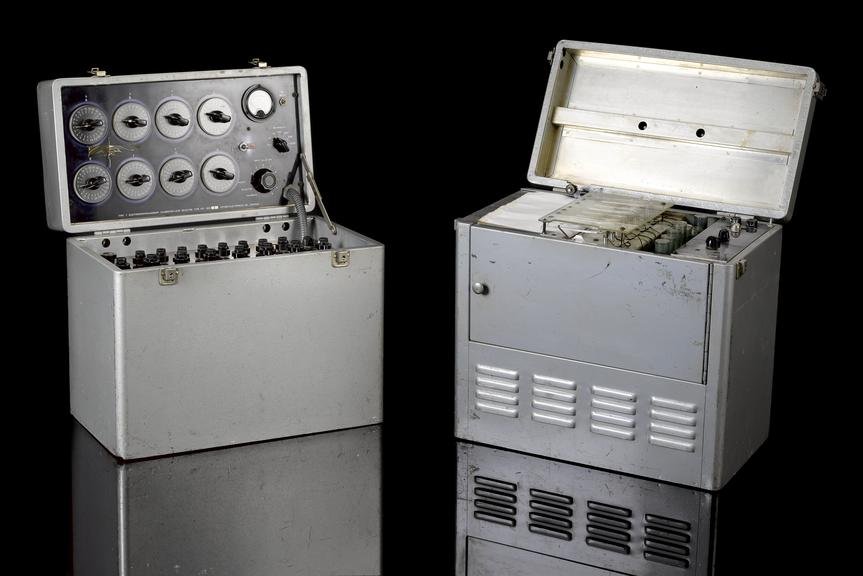
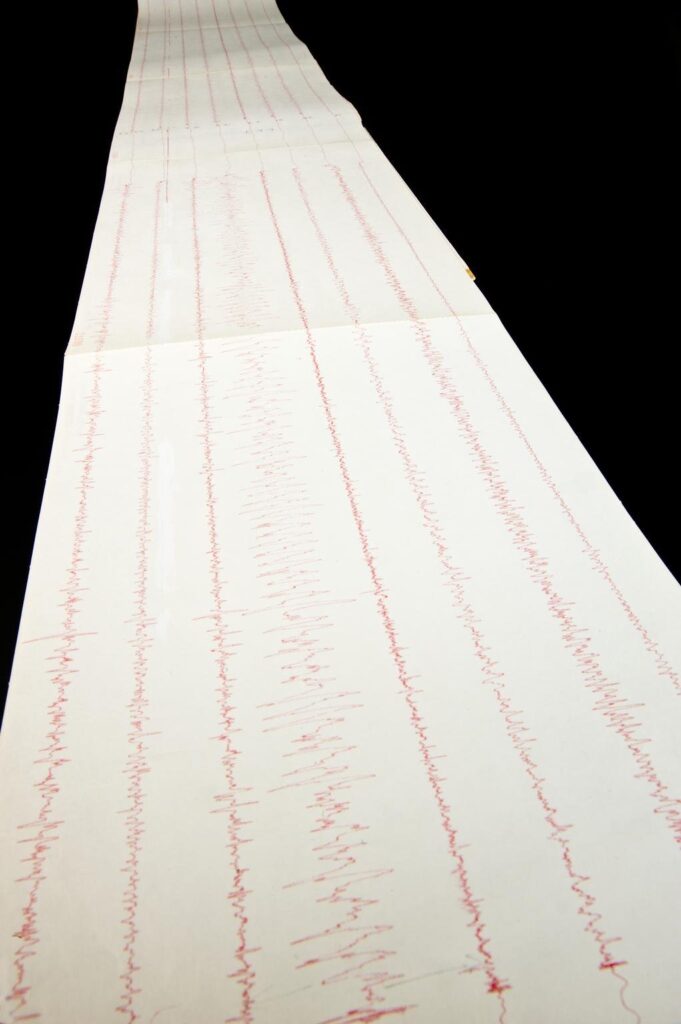
A revisionist history published in this SMG Journal article employs research on photographs and promotional materials within the BNI archives to foreground the vital role of women in the EEG research undertaken at the Burden that has been largely written out of its history (Saunders, 2018). The aims of OoM and SMG align here in bringing to the centre these important stories about women’s historical roles in EEG research at the Burden and elsewhere, including in fictional representations. As discussed above, the Science Museum has an outstanding collection of the BNI’s EEG technologies on display in the Wellcome galleries and uses these to foreground the important medical breakthroughs made by the female and male researchers and doctors therein.
However, in order to highlight the supplementary role that our OoM research has contributed to adding layers of historicity to the objects in the collection, we will move on to foreground another largely forgotten (mis)use of the EEG shown in The Brain Machine: its central narrative use in the film of diagnosing criminal psychopaths. This dramatic framing of the EEG as a device for identifying potential murderers is ideal for a popular genre film and is centred in the promotional campaign for the film. This includes a suggested display for cinema foyers showing the divergent EEG readings of a ‘normal man and a second shows a man with violent tendencies so strong that he is quite likely at some time to commit murder’.[5] As our OoM film shows, this use of the EEG in the film has a historical grounding in the research in the mid-1940s to early 1950s by psychiatrists such as Denis Hill at the Maudsley Hospital and in prison settings, investigating the brain activity of criminal psychopaths and murderers (Hayward, 2001, p 625). This (mis)use of the EEG is less explored in histories of the technology and technique of electroencephalography, and whilst the Science Museum has an EEG in their collection that was used in this research by Hill, it is not on display in the medical galleries.
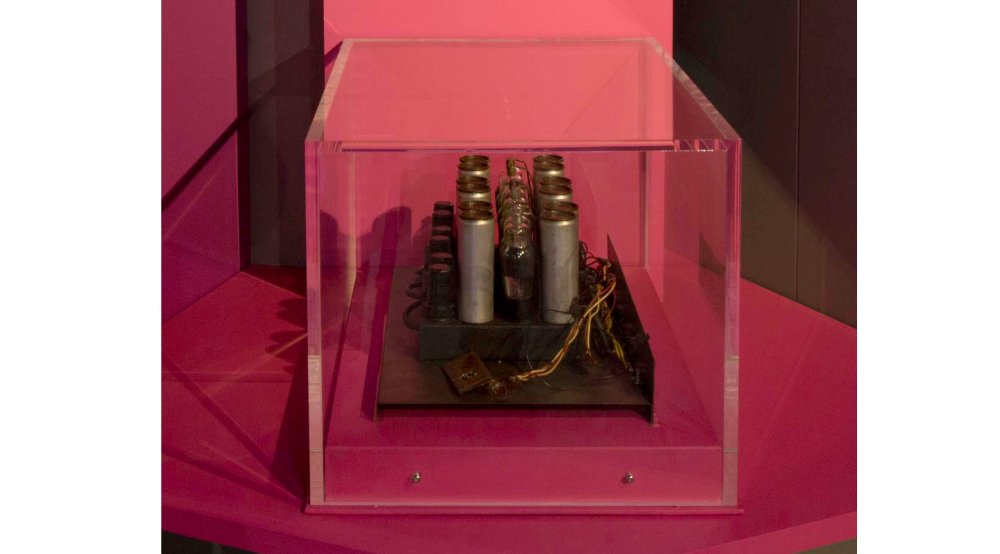
Although this forensic use of the EEG has largely been forgotten in medical histories and museum settings, research on The Brain Machine suggest that this idea of the EEG as being a device predominantly used with criminal psychopaths was how it was mostly positioned within mainstream newspapers in the mid-1940s to mid-1950s, including the coining of the term ‘brain machine’ to describe the EEG. The film can be understood, largely, as a response to this media framing and, it could be argued therefore, a dominant public perception of the technology at the time. Across a series of broadsheet and tabloid newspaper articles from 1949–1955 – with titles such ‘Brain machine in murder case’, ‘Brain machine can never be a judge’ and ‘Doctors argue at trial about brain machine’ – a converging media and medical debate was propagated about the efficacy and ethics of using the EEG in testing criminal psychopaths. In particular, many of these reports questioned the use of EEG recordings as evidence in murder trials for insanity defences. This was highlighted as an issue of extreme contention within the psychiatric professions as well as in the legal system.[6] Both the Daily Mail and Daily Telegraph reported on 3 February 1950 that ‘the brain machine went on trial today’ in front of the Royal Commission on Capital Punishment (Daily Mail reporter, 1950, p 5). Denis Hill was called upon to discuss and show the EEG tests he conducted on murderer Daniel Raven, who used the results in his unsuccessful insanity defence appeal in 1949, and in his assessment of 94 other murderers using ‘the electro-encephalograph brain machine’. Hill explained that his ongoing research indicated that a relationship ‘appears to exist between “inadequately motivated murder” and EEG abnormality’ but suggested that more ‘intensive medical research’ was needed (‘Brain machine in murder case’, 1950, p 5).
Subsequent reports in the Daily Mail, Daily Record, Daily Mirror, The Times, Daily Telegraph and the Guardian discussed both the research undertaken in prisons with murderers (by Hill and others) and the use of ‘brain machine’ research in insanity defences – both successfully and unsuccessfully. Some psychiatrists in the newspaper articles also marshalled the evidence of the EEG abnormalities as a case for the abolition of capital punishment in Britain (‘Psychiatrist says: end hanging’, 1955, p 3). Whilst there was considerable discussion of the EEG’s use in relation to epilepsy and other neurological conditions in contemporary scientific studies (MacKay, 1954; Hill, 1956), there was very little reporting of this in the sample of mainstream press reporting we analysed for the period of the 1940s and 1950s. In our sample, only one Times article written by a ‘Special Correspondent’ mentioned the EEG’s role in providing ‘new information about epilepsy and allied disorders’ in a report on a new fund for UK mental health research (1953, p 5).[7] Conversely, there are more than twenty national newspaper reports (and many more in local newspapers) about the use of EEGs with criminals in prison settings and within murder trials in the five-year period from 1949–1954. Many of these articles used the term ‘brain machine’ interchangeably with or instead of electroencephalograph, as did the local newspaper reports on these and other criminal cases.
The example of The Brain Machine demonstrates how looking to and across popular media discourse at the time can open up potential for new stories outside intended or dominant historical use that, whilst appearing as a minor digression in terms of medical history, can be enlightening in regards to understanding media and public perceptions about science at specific moments as they converge with other public and professional debates (the role of psychiatric evidence in the insanity defence; the implications of this for the capital punishment debate, etc.). The film The Brain Machine and its relationship to ongoing media reports about the contentious use of ‘brain machines’ in detecting and protecting murderers, suggests that in public consciousness the EEG was likely to have been largely understood as a (controversial) machine used on dangerous criminals. What might, therefore, it have felt like for a ‘normal’ person to be prescribed an electroencephalograph test in 1955? This raises interesting questions and potential new areas for more in-depth research.
The straitjacket: using a material objects’ perspective in media studies
The collaboration with curators across the Science Museum Group has been enlivening to us as media scholars. Employing a material objects’ perspective has opened up the possibilities to reveal ‘entangled’ and ‘hidden’ stories across different forms of historical media and popular culture that might not be considered together before. The third OoM film demonstrates the processes and value of this knowledge exchange, utilising a case study of the straitjacket, which is still the paradigmatic psychiatric symbol even though it is largely no longer used in mental health settings. The straitjacket might be seen as the odd-one-out in our selection of objects too. Whilst Lowenfeld’s sand trays and the EEG are intended to make patient’s inner worlds visible, the straitjacket is designed to restrict the interaction of the patient’s inner world with the external world. Partly for this reason, it has become a potent symbol of inner struggles and, latterly, individual and collective struggles against societal restrictions. A contemporary example of this contentious object (c. 1930–1960) to the one depicted in Morgan! A Suitable Case for Treatment (1966) is on display in the ‘medical isolation’ area of the Medicine and Communities gallery.

The OoM film we made tells a fairly linear story of the straitjacket’s appropriation into popular culture, from Houdini to horror films to hip-hop. We are aware, however, that this history – in some ways paralleling the longer medical history of the straitjacket – is more complex and contested. Across a range of popular cultural forms, it continues to be a complex symbol representing, sometimes simultaneously, ‘a visual shorthand for psychiatric cruelty’ and ‘the dangerousness of the wearer’ (Chaney, 2022, pp 3–4). It is an overloaded metaphor that with every new articulation draws upon and adds to the (sub)cultural uses of Dr Caligari, Morgan, Johnny Rotten, Lil Wayne and so on, depicted in the below OoM film.
and Communities gallery.
The work of Caitlin Benson-Allott on the ‘stuff of media’ has been useful for us in considering how thinking about media culture with and through material culture can allow media historians to ‘embrace the messiness of media convergence’. She explains, ‘Medium specificity can be a convenient fiction in certain circumstances, but is always – and only – an expedient elision of a more complicated story’ (Benson-Allott, 2021, p 13). She looks at a range of objects that have materially influenced historical experiences of film spectatorship – from video formats and packaging to the alcohol consumed in cinemas – rather than those employed within processes of production. However, we feel, her assertions that an objects’ perspective ‘invites scholars to consider how a text’s composition and narratives are understood in conversation with the physical world’ (19) is translatable to the Science Museum objects we are focusing on. This is not just about making connections across media and across collections to disrupt usual taxonomies – though that in itself is important for drawing attention to taken-for-granted assumptions within and across professional fields. But, if we see these objects as embodying the power of scientific and medical knowledge, then identifying the cumulative effects of restaging these embodied discourses across a range of media opens up potential for ideological critique. Benson-Allot continues, ‘Material culture is always political, as are media cultures. Thinking them together helps us recognise and contest their power’ (15). The straitjacket is a great example of the political potential of thinking material cultures and media culture together.
Our film shows how the straitjacket has been appropriated across a range of twentieth century popular culture in order to exploit its dominant meaning (danger of the wearer) or provoke a resistant meaning (danger of the system), or both. By focusing on a specific historical moment, particularly an ideologically charged one, and mapping the recurrent uses of a particular object across a range of media and public discourse, we can begin to see patterns that might otherwise remain hidden. For example, if we look at the immediate post-war period in America we can see how the image of the straitjacket – and particularly a woman in a straitjacket – was marshalled across a range of journalistic, scholarly and popular cultural forms, to provoke rethinking and reform in the treatment of mental health patients. In analysing a range of key primary sources from this period, the evocation of the straitjacket as a short-hand for the rigidity and inhumanity of the system could be seen as a key mechanism in the processes of deinstitutionalisation and a shift towards community-based care in America. Albert Maisel’s 1946 Life magazine article titled ‘Bedlam 1946’ was one of the first and most influential exposés of the shameful treatment within American mental institutions and used images of women in straitjackets, lying on the floor and abandoned on wooden benches, to represent the systemic neglect and restraint therein.
The Life article activated not only public awareness of the ‘shame and disgrace’ of US mental hospitals but also a cycle of other media interventions. In 1948, for example, the image of a woman in a straitjacket was used on the cover of prize-winning journalist Albert Deutsch’s bestselling book The Shame of the States (1948) and was also the central plot device in the Twentieth Century-Fox psychological drama The Snake Pit (1948). Like the Life article, The Snake Pit employed shocking images of its star Olivia De Havilland being forcibly restrained on the floor in a straitjacket as the crux of its ‘reformist propaganda’ argument, with this mistreatment leading to the intervention of a kindly psychotherapist and her resultant recovery (Harris, 2021, p 2). The Shame of the States and The Snake Pit were cited both at the time and in contemporary scholarship as directly influencing public opinion and policy makers (Isaac and Armat, 1990, p 113; Harris, 2021).
In addition to these prestige productions, similar points were made across a range of more low-cultural forms, including Marvel comic books. For example, the cover of a 1948 issue of Lawbreakers Always Lose shows a man being wrestled into a straitjacket whilst a journalist peers through the barred window comments, ‘This is all the proof I need to bust wide open this phoney sanatorium racket!’ However, this ‘deinstitutionalisation’ discourse was not unitary. In the Hollywood gangster film White Heat (1949), James Cagney’s psychotic criminal ‘Cody’ Jarrett exploits the liberalism of the mental institution, persuading a psychiatrist to undo the straps on his straitjacket so he can retrieve a hidden gun and escape. This crime film uses the straitjacket for very different dramatic and rhetorical purposes, with this systemic failure implying a need for more rather than less incarceration and restraint.
The debates within material culture studies around whether objects have agency are interesting to invoke in this regard. We would tend to ascribe to Knappert’s assertion that objects cannot have agency in their own right but, ‘when imbued by humans with a purpose, an object may act in a manner similar to that of an agent’ (2005, p 19). Through this interaction with filmmakers, musicians, illustrators, illusionists, an object such as the straitjacket is activated as ‘agent-object hybrid’ that can, through its appropriation and rearticulation, help to promote change in the material world. Borrowing an objects’ perspective from museum studies and material culture studies offers new ways, therefore, to revitalise and re-politicise textual analysis, ‘a long-esteemed methodology of film and media studies that has fallen out of favour in the twenty-first century’ (Benson-Allott, 2021, p 249).
Fangs, formats and fans: curating connections between horror cinema and psychology
This final section will highlight how our three films connect to the engagement strategies within the wider Objects of the Mind project. The starting point for the OoM research was creating a new series for the SMG’s ‘Objects and Stories’ platform based on the theme of ‘Cinema and Psychology’ which used clips from popular films as a mechanism for making connections across museum collections. We wanted these connections to be meaningful in looking at specific medical and media objects (or their historical equivalents within the collections) that played a concrete role within the production processes of the films, and how these technologies created specific psychological effects on screen. This research for the Objects and Stories pages fed into the three films embedded within this article. We also created innovative audio-documentaries with The Cinematologists podcast that sought to communicate our findings through an aural rather than visual framing.
We designed and programmed a range of live and online cultural events with the SCM, NSMM and screen education partners INTO Film. The NSMM already makes extensive and innovative use of fiction films in its permanent exhibitions and film programming for the public that are related to its collections. However, OoM offered them the opportunity to make rare connections with the Science Museum’s collections (as discussed above in relation to child therapy and films) as well as communicating some new stories that spoke across its own collections. An example of this was the screening of Dracula: Prince of Darkness (1965) as part of the NSMM’s Widescreen Weekend festival. Historian of science, technology and medicine, Ray Macauley, introduced the screening and highlighted how filmmakers used a range of audio-visual techniques to elicit audiences’ emotions: the widescreen ‘Techniscope’ format, non-naturalistic make-up, vivid colour palette (especially, in this classic Hammer horror film, saturated primary reds to depict blood), and James Bernard’s innovative orchestral score. This allowed us to make links across the NSMM’s cinematography and sound technologies collections, feeding into the Museum’s aims to foster these connections – this aim is central to the plans for to its new Sound and Vision galleries (opening in 2025 to coincide with Bradford City of Culture).
The Dracula screening was distinctive for the NSMM in being object-driven, with the choice of film selected in order to introduce visitors to items from the collection, in this case the Ashton and Leakey special effects and make-up collection, rather than being programming driven. The screening was followed by tours of the Museum store for a close encounter with the materials and tools used by Hammer horror make-up pioneers Roy Ashton and Phil Leakey to create Christopher Lee’s Dracula, and many other iconic cinema ‘monsters’, including Frankenstein’s Monster, the Mummy, and the tragically alien-infected Victor Caroon in The Quatermass Experiment (1955). The tour highlight was a set of fangs, custom-made for Lee, complete with a bladder that allowed Lee to drip blood during scenes.
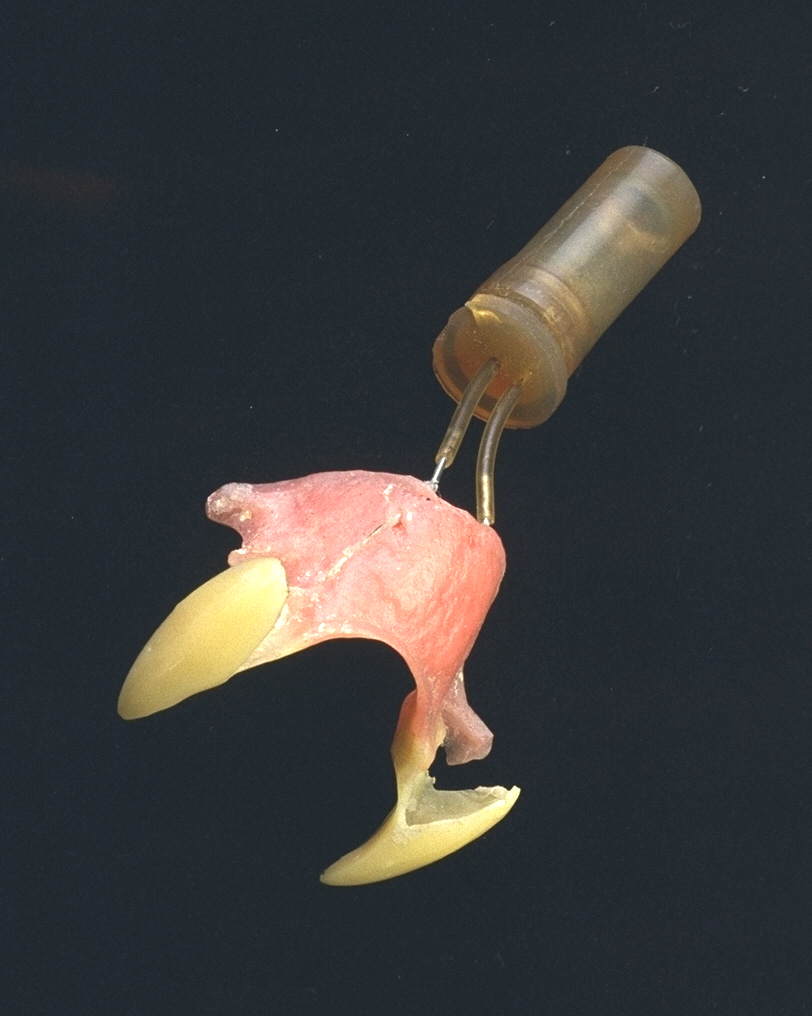
The collection includes artefacts from the many stages of the make-up design process, from hand-drawn sketches and early models, through maquettes, to final make-up and prosthetics, character and set photographs. The tour, and accompanying talk by NSMM curator Annie Jamieson, encouraged visitors to reflect on the many different aspects of cinema that contribute to the scares we crave in horror films. Participants of the tour were keen to discuss how the cinematic experience allows us to suspend disbelief, and experience strong emotions such as apprehension and fear, even though the effects, when seen up close in the light of day, might seem very mundane, even comical. For example, for The Quatermass Experiment, the character Caroon’s alien ‘lesions’ were made using cornflakes and rice grains. The screening and tour also provided first-hand evidence of the value of the aura of an object. Whilst there were several participants who were horror make-up enthusiasts, and interested in the Ashton and Leakey collection for its cinema history value, more were drawn in and actively engaged by the fact that the fangs were the same ones they had just seen in the film. The event was able to attract new specialist audiences for the Museum, many of whom, as post-tour feedback demonstrated, did not realise that the Museum had these types of objects within their collection, and which spoke directly to their experiences and interests as horror fans.
The intersections of histories of horror cinema and medical histories have been central to both the Demons of the Mind and Objects of the Mind projects. From the beginnings of the Gothic novel in the late eighteenth century, this literary genre was heavily invested in exploring the nature and causes of ‘madness’, and many of these classic novels were the source materials for Hammer horror films. From its silent era onwards, cinema developed its own visual language for exploring psychological themes, including in the influential silent German expressionist film Das Cabinet des Dr. Caligari (1920), which is discussed in our straitjacket film. After Alfred Hitchcock’s Psycho (1960), however, film critics identified an increasing psychologisation of horror, with such films offering a more nuanced exploration of the causes and conceptions of mental illness (Tudor, 1989). As we explain in our project book, Demons of the Mind, this even manifested in the seemingly ‘schlocky’ Hammer horror films that came in its wake, such as the Psycho-inspired Paranoiac (1963), which was promoted as ‘aimed at the arm-chair-psychiatrist’ (Snelson, Macauley and Kirby, 2024: 11). Our project highlights that popular films – even seemingly lurid horror movies – are worth taking seriously for the ways in which they seek to engage audiences in scientific dialogue.
The project’s aim to use popular fiction films to provoke new understandings and engagement with medical science was key to our collaboration with the Science Museum in London. Our key live event at the Science Museum was a contribution to the ‘NHS’s 75th birthday’ Lates in July 2023, where we screened our three short films (embedded within this article) alongside their corresponding objects on display within the Wellcome medical galleries. Whilst the NSMM had used fiction film before on gallery, to highlight, for example, how a filmmaker like R W Paul employed objects in their collections within his work (such as the Animatograph camera he invented), the medical galleries have not used fiction films in this way before. They do use factual documentary films, such as the Bug Van in Action (1935) archive footage exhibited in the ‘Healthier Housing’ display. However, one of the Museum’s medicine curators explained that there was a concern with using fiction films on gallery in case people ‘take them seriously’, in effect, interpreting these fictional depictions as fact.
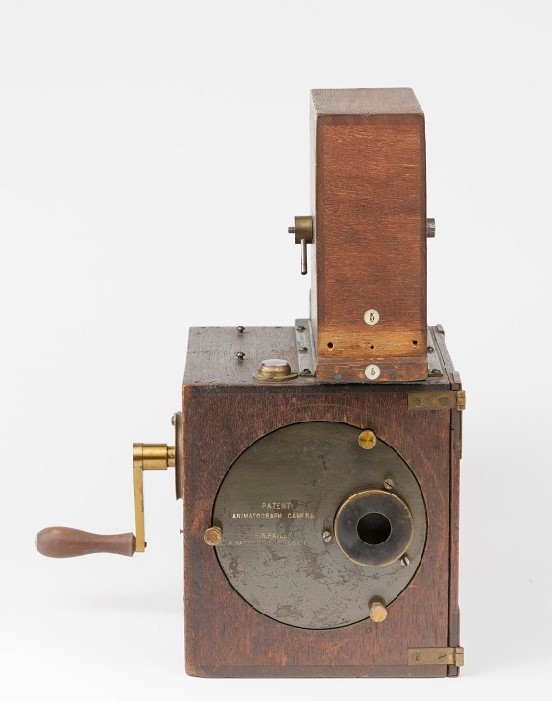
As media scholars, we would share these concerns regarding audiences accepting these representations as fact but would extend this concern to other forms of mediation, whether ‘factual’ documentary films or the oral testimonies played over headphones in the ‘In the Therapist’s Room’ display. All media is mediated, its content is selected, edited and framed in a purposeful way to make a particular point. It could be argued, perhaps facetiously, that less rather than more care is needed in flagging up to the Science Museum’s media-literate visitors that these fictionalised depictions of science are not to be taken as factual. The project, therefore, raises some wider questions relating to museum practices and culture that are of interest to us as media scholars, historians, and curators. The affective fictional narratives we are introducing to the galleries might enhance rather than hinder the Wellcome galleries’ mission to emphasise ‘the personal element’ with ‘the role of the patient placed on equal footing to that of the medical practitioner’ (Bond et al, 2020).
Conclusion
Working with and across the extensive and diverse collections of the SMG, and resultantly adopting a more object-focused perspective favoured by the museum curators, was enlivening for us as historians of media and medicine. It allowed us to think outside the restrictions of medium specificity, established genres and taxonomies, and accepted periodisation to think across media and eras and bring new connections and stories – all with much at stake ideologically – into view. In regard to enhancing museum culture, the project and its focus on fiction films certainly allowed us to foster cross-collection dialogue, bringing to light ‘entangled stories’ that spoke across the Science Museum Group’s medical and media collections around themes such as children’s inner worlds. The Objects and Stories theme we created and the three films we made and displayed on-gallery – employing clips from old fiction films – contributed to the SMG’s agenda to grow science capital through innovative digital and on-gallery engagement with the collections. Additionally, it spoke to the Wellcome galleries’ key curatorial aim of ‘capturing the personal experiences of makers, users and practitioners, particularly those whose voices have been excluded from the Science Museum’s collections and displays in the past’ (Bond et al, 2020). Whilst the personal experiences depicted in the movies we have used are fictional, they offer an accessibility and legibility for museum visitors (online and on-gallery) and an opportunity for a more open and pluralistic idea of historiography.
Audience research conducted at the Lates event, albeit with a limited sample of the 2,000+ visitors, highlighted that those who watched the films we made all agreed (or strongly agreed) that they helped to ‘bring the objects to life’ and enhanced both their historical understanding of the objects and of cinema’s ‘serious’ engagement with science in the past. A number of the respondents felt that the placement of the films by the objects was central to invoking a change in understanding. It was particularly rewarding to see visitors making this observation that the spark came as a result of the in situ dialogue between the material objects and the adjacent old movie clips featuring their (mis)uses, which we were able to rekindle a lifetime after they were originally made.
Acknowledgements
This work was supported by the Arts and Humanities Research Council (grant number AH/W002140/1) and constitutes part of Objects of the Mind: engaging publics in the material cultures of media and mental health project, which was co-investigated by University of East Anglia and the Science Museum Group. A huge thanks to Efram Sera-Shriar, Geoff Belknap and Tim Boon, who helped put this project together, and to the project steering committee: Rhodri Hayward, Geoff Bunn, Mina Husain and Ani Bailey. The project website is at: www.psychologyandcinema.com








